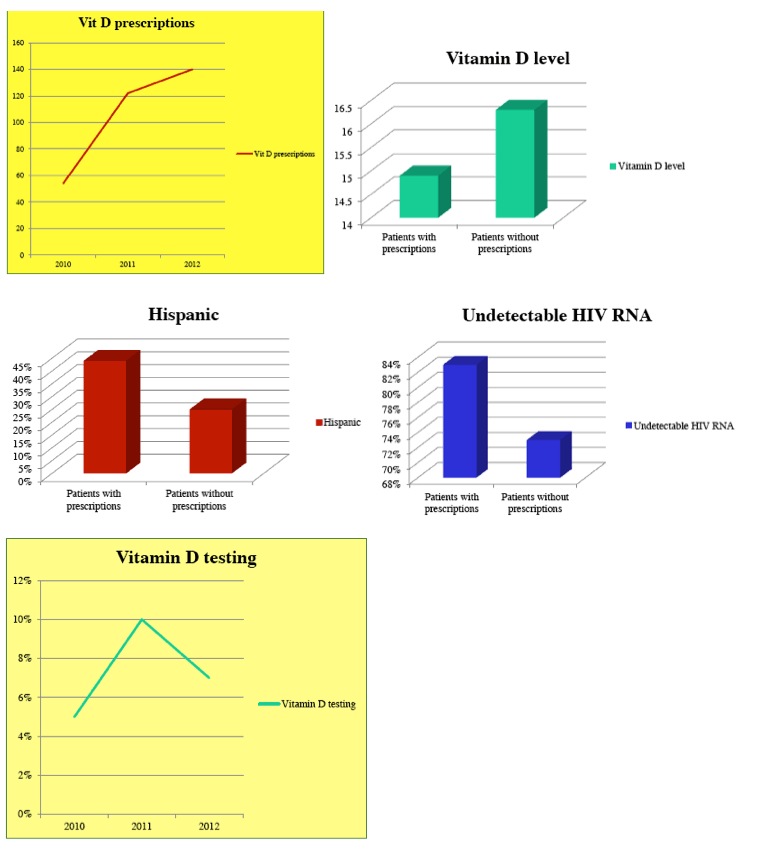 |
 |
 |
| |
Assessing Vitamin D Testing and Supplementation Patterns in a Large Inner City Clinic
|
| |
| |
Reported by Jules Levin
IDSA Oct 2-6 2013, San Francisco, CA
Jose Gonzales, MD,1 Anna Hotton, PhD, MPH,2 Blake Max, PharmD, Oluwatoyin Adeyemi MD3.
Section of Infectious Diseases, Rush University Medical Center, Chicago, IL1, Chicago Developmental Center for AIDS Research (D-CFAR) 2
Ruth M Rothstein CORE Center, Cook County Hospital3.
CONCLUSIONS
In our clinic Hispanic patients were more likely to receive vitamin D prescriptions and Mid-level providers were disproportionally represented as prescribers of vitamin D. There were an increasing number of vitamin D tests and prescriptions from 2010 to 2012, but overall screening and prescribing were low which likely reflects the lack of formal guidelines
INTRODUCTION
Vitamin D (Vit D) deficiency is common among HIV-infected adults; however recommendations on screening and Vit D supplementation remain sparse and controversial.
Methods
->We examined vitamin D testing and prescribing patterns among HIV-infected adults in primary care at the Ruth M. Rothstein CORE Center in Chicago from January 2010 to June 2012. Sufficient Vit D >30ng/ml.
-> Trends over time in Vit D prescribing and testing were examined by nonparametric tests. Chi-square tests were used to examine factors associated with filling prescriptions for Vit D.
RESULTS
->790 prescriptions for Vit D were filled in our pharmacy by 265 patients. Patients were 45% Hispanic, 42% African-American, and 12% Caucasian; 36 %were female and 64%were male. [Larger CORE demographics: 68% African American, 22% Hispanic, 10% Caucasian, 75% male].
->The median age was 45 (IQR, 22-76) years. Median CD4 count was 399 (19-1489) and 83% had undetectable HIV RNA. Median vit D level was 15.5 ng/ml (IQR 10.9-21.1).
-> The proportion of patients prescribed Vit D increased from 54/5101 (1%) in 2010 to 140/4425 (3%) in the first half of 2012 (p<0.001).
->Vit D testing increased from 5% in 2010 to 10% in 2011 but declined to 7% in 2012.
->The most commonly prescribed Vit D doses were 50000 IU once a week (72%) or 50000 IU once a month (23%).
->Mid- level providers (nurse practitioners and Physician assistants) represent 30% of the providers in our clinic but accounted for 58% of prescriptions for Vit D; attending physicians and trainees accounted for 38% and 3% of prescriptions respectively.
->Compared to patients who filled Vit D prescriptions, those who had insufficient and deficient vitamin D (<30 ng/ml) but no prescriptions filled (n=778) had higher vitamin D levels (16.3 ng/ml vs. 14.9 ng/ml; p=0.028), were less likely Hispanic (25% vs. 44%; p<0.001), and less likely to have undetectable HIV RNA (73% vs. 83%; p=0.004).

References
Kathyrn Childs, Tanya Welz, Amanda Samarawickrama, Frank A. Post. Effects of vitamin D deficiency and combination antiretroviral therapy on bone in HIV positive patients. AIDS 2012, 26: 253-262.
Kara J. Pepper, Suzanne E. Judd, Mark S. Nanes, Vin Tangpricha. Evaluation of Vitamin D repletion regimens to correct Vitamin D status in adults. Endocr Pract. 2009; 15 (2): 95-103.
|
| |
|
 |
 |
|
|